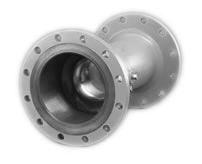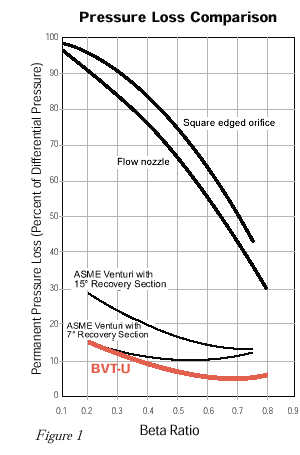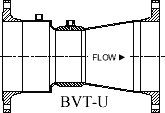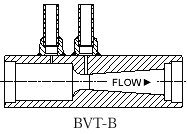 Wyatt Venturi Tubes
Wyatt Venturi Tubes
Fabricated Primary Elements
Features:
- High Accuracy
- Low Pressure Loss
- Application Specific Design
- Static Pressure Sensation
- Documented Performance
Description
Wyatt Venturi Tubes are available as a fabricated series of modified venturi flow elements that can be used to measure the flow of gases and liquids over an extreme range of temperatures and pressures in full pipes. The fabricated BVT maintains its accuracy over a greater range of flow rates, and incurs lower permanent pressure loss than either the ISO or ASME venturi designs. Wyatt’s fabricated BVT series can be manufactured from virtually any metal or alloy. Each unit, therefore, can be designed specifically for your application.
Application
The fabricated series of BVTs are most often used in industrial applications where the flow stream demands specific material selection due to pressure and/or temperature, or the corrosive/erosive properties of the fluid being measured. BVT installations are found in:
- Power Plants
- Refineries
- Petrochemical Plants
- Cryogenic Processes
- Coal Gasification Plants
- Steam Custody Transfer
Flow Measurement Accuracy
For pipe Reynolds numbersgreater than 75 000 and with anormalized piping configuration,the Wyatt BVT-U providesa flow measurement accuracy of± 0.50% without flow calibration.With independent flow calibration,Wyatt Engineering’s venturi meterswill provide the user with ± 0.25%accuracy.
BVT-U Technical Specifications
Accuracy
For pipe Reynolds numbers greater than 75 000 and with a normalized piping configuration, the Wyatt Venturi Tube provides a flow measure-ment uncertainty of:
± 0.50% for standard meters and
± 0.25% for flow calibrated meters.

Pressure Loss
The permanent pressure loss of the fabricated BVT product line is significantly lower than that of short-form venturis, and, for most beta ratios, lower than that of long-form venturis as well. Call Wyatt Engineering for detailed headloss information on the design and process data for your application.
Beta Ratio
Wyatt Engineering can furnish fabricated BVT products with any beta ratio. This provides users with accurate flow measurement over a broad range of flow rates for a given line size.
Temperature Range
The fabricated BVT-U can operate over the fluid temperature range of -425 °F to +1200 °F (-250 °C to +650 °C).
Pressure Range/End Connections
Flanged end connections, per ANSI B16.5 for 150 PSIG through 2500 PSIG service, are available. Various end connections are also available, including plate, slip-on, weld neck, Van Stone, RTJ, or beveled (for butt-welding).
Piping Requirements
Designed for full pipe flow, BVT flow meters can be installed horizontally, vertically, or on an angle. For the recommended piping and installation requirements, refer to Wyatt Engineering Technical Manual for the BVT.
Signal to Noise Ratio
Within the specified flow range and piping conditions, the BVT will produce signal-to-noise ratios greater than 98%. This level of performance is essential
for sensitive process control and reactive rate-of-flow control applications.
Design
The BVT hydraulic design produces a predictable and reliable discharge coefficient. The static pressure taps and smooth transition section minimize flow noise and lessen the effects of aging, corrosion, and/or erosion. Flow measurement of compressible fluids is performed accurately and reliably.
BVT-U Available Options
Fabricated BVT units are available in four styles:
 Model BVT-U is designed to the ASME Boiler and Pressure Vessel Code. It is typically used at operating pressures less than 400 PSIG (2 750 kPaG) and tempera-tures less than +500 °F (+260 °C). The unique construc-tion of the BVT-U allows for custom designs. For example, the throat can be manufactured from a specific alloy for maximum abra-sion resistance, while the exit cone can be constructed with a different alloy for corrosion resistance. For flexibility, multiple pressure connections are available.
Model BVT-U is designed to the ASME Boiler and Pressure Vessel Code. It is typically used at operating pressures less than 400 PSIG (2 750 kPaG) and tempera-tures less than +500 °F (+260 °C). The unique construc-tion of the BVT-U allows for custom designs. For example, the throat can be manufactured from a specific alloy for maximum abra-sion resistance, while the exit cone can be constructed with a different alloy for corrosion resistance. For flexibility, multiple pressure connections are available.
Model BVT-F is used for more demanding process temperatures and pressures. Its pipe-shell design can be constructed and certified to meet the requirements of B31.1 and B31.3. The BVT-F is available in flanged and plain-end designs. Model BVT-B is designed for service in which demanding process conditions require a uniquely rugged design. Machined from forged bar material, it is ideally suited for applica-tions in which extreme tempera-ture cycling and/or pressure cycling is encoun-tered, such as the power industry. While the most common sizes are 6 inches (150mm) and less, the Wyatt bar stock design has been made from 26″ (660mm) diameter bar stock material.
 Model BVT-B is designed for service in which demanding process conditions require a uniquely rugged design. Machined from forged bar material, it is ideally suited for applica-tions in which extreme tempera-ture cycling and/or pressure cycling is encoun-tered, such as the power industry. While the most common sizes are 6 inches (150mm) and less, the Wyatt bar stock design has been made from 26″ (660mm) diameter bar stock material.
Model BVT-B is designed for service in which demanding process conditions require a uniquely rugged design. Machined from forged bar material, it is ideally suited for applica-tions in which extreme tempera-ture cycling and/or pressure cycling is encoun-tered, such as the power industry. While the most common sizes are 6 inches (150mm) and less, the Wyatt bar stock design has been made from 26″ (660mm) diameter bar stock material.
Model BVT-IF is designed for insertion within the interior of a pipeline and can be secured by companion flanges or welded directly into your pipeline. For more information on fabricated insert BVTs, see the Wyatt Engineering BVT-IF TechBrief.
Materials of Construction
The versatile BVT design can be constructed from almost any material, including:
- Carbon Steel
- 304 Stainless Steel
- 316 Stainless Steel
- Inconel
- Hastelloy B & C
- Monel
- Titanium
- Chrome Molybdenum
- Nickel
- Tantalum
- Zirconium
Consult your local representative or Wyatt Engineering for information on other materials of construction.